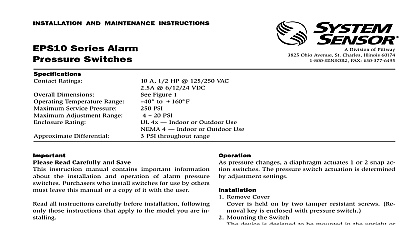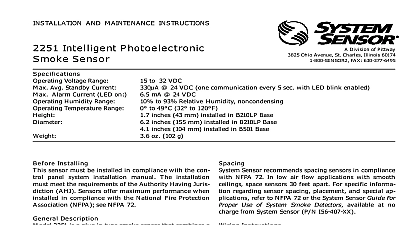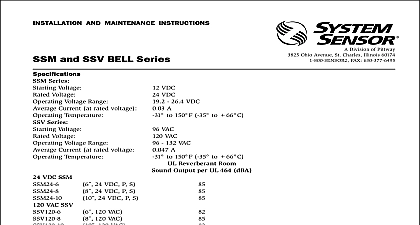System Sensor eps 40 Series Install and Maint Instructions

File Preview
Click below to download for free
Click below to download for free
File Data
| Name | system-sensor-eps-40-series-install-and-maint-instructions-9317260854.pdf |
|---|---|
| Type | |
| Size | 676.54 KB |
| Downloads |
Text Preview
INSTALLATION AND MAINTENANCE INSTRUCTIONS Series and EPS120 Series Pressure Switches SENSOR Division of Pittway 3825 Ohio Avenue St Charles Illinois 60174 FAX 630 377 6495 Ratings Dimensions Temperature Range Service Pressure Range Rating Differential A 1 2 HP 125 250 VAC 6 12 24 VDC Figure 1 F to 160 F EPS40 2 PSI EPS120 2 250 PSI PSI EPS40 2 EPS120 2 10 200 PSI 4x Indoor or Outdoor Use 4 Indoor or Outdoor Use EPS40 2 PSI at 10 PSI PSI at 100 PSI EPS120 2 3 PSI at 10 PSI PSI at 200 PSI Read Carefully and Save instruction manual contains important information the installation and operation of supervisory pres switches Purchasers who install switches for use by must leave this manual or a copy of it with the user all instructions carefully before installation following those instructions that apply to the model you are in not use in potentially explosive atmospheres Do not unused wires exposed pressure changes a diaphragm actuates 1 or 2 snap ac switches The pressure switch actuation is determined adjustment settings installing any alarm device be thoroughly familiar 1 Pressure switch basic dimensions 72 National Fire Alarm Code 13 25 of Sprinkler Systems Testing and Maintenance of Water Fire Protection Systems 13D Standard for 1 and 2 Family Dwellings and Homes 13R Standard for Multi family Dwellings applicable NFPA standards local codes and the re of the authority having jurisdiction to follow these directions may result in failure of the to report an alarm condition System Sensor is not for devices that have been improperly installed or maintained SCREW Manuals Online 2 ADJUSTMENT NPT 2 Typical piping diagram for EPS40 1 3 Typical piping diagram for EPS120 1 TO SUPERVISORY OF FIRE ALARM PANEL TO ALARM CIRCUIT FIRE ALARM PANEL FOR Y SYSTEM ALARM OFF LINE Y Y ALARM OFF Remove Cover is held on by two screws Mounting the Switch device is designed to be mounted in the upright po side mounting is also acceptable Locate it where shock and mechanical loading are minimal to piping diagram above Figures 2 and 3 Mount the device directly to the line via the 1 2 NPT connection The use of teflon pipe sealant is recommended Be sure the fitting is tight to prevent leaks Apply tightening torque to the black plastic hex por of the device 4 Switch location 1 2 I T voltage Electrocution hazard Do not handle live AC or work on a device to which AC power is applied so may result in severe injury or death Wire the device in accordance with the National Electri Code Two 7 8 diameter conduit connection holes been provided in the mounting plate to accept stan 1 2 conduit fittings one is removable knock out If a NEMA 4 UL 4x waterproof unit is required flexible metallic conduit and appropriate fittings must be used Recommended connectors Thomas and Betts PN 5332 180 coupling PN 5352 coupling and PN 5262 seal ring Connect wiring to terminals see Figure 4 and Table 1 1 Electrical connections referenced at factory EPS40 1 EPS120 1 EPS40 2 EPS120 2 AT NORMAL SYSTEM PRESSURE AT TRIP POINT 1 AT LOW TRIP POINT AT NORMAL SYSTEM PRESSURE AT HIGH TRIP POINT WIRE AS SHOWN FOR OF CONNECTION NOT ALLOW STRIPPED WIRE TO EXTEND BEYOND HOUSING DO NOT WIRES Manuals Online To Factory Settings 5 Adjustments Dual switch model shown 2 SETTINGS PSI SW2 Switch 1.5 1.5 112.5 112.5 SW1 Switch 2.5 128.5 2 SWITCH AND HEX HEAD PRESENT IN SWITCH 1 SWITCH AND EPS120 2 SWITCH EPS40 1 ADJUSTING WHEEL COUNTERCLOCKWISE INCREASE PRESSURE Model EPS40 1 and EPS120 1 Install pressure switch as stated in of instruction manual Attach pressure test to system Back off locking screw see Figure 1 to allow main ad wheel to rotate freely Test the switch for the set point by introducing 40 PSI from the pressure test source for the EPS40 1 PSI for the EPS120 1 Decrease pressure slowly un the switch trips Rotate main adjustment wheel Fig 5 counterclockwise to increase pressure and retest first introducing a higher pressure than desired and reducing pressure until the switch trips Repeat until switch trip point is at desired pressure set Each number represents an approximate trip point of 1.8 PSI for the EPS40 1 and 6.6 PSI for the EPS For each 1 2 rotation of the adjustment wheel the point setting changes by approximately 11 PSI for EPS 40 1 and 40 PSI for the EPS 120 1 Retest the set point several times to ensure accuracy of Re seat locking screw Model EPS40 2 and EPS120 2 Install pressure switch as stated in of instruction manual Attach pressure test to system Back off locking screw see Figure 1 to allow main ad wheel to rotate freely Option 1 To adjust the nominal setting of the pressure low switch setting to high switch setting with affecting the size of the window adjust the main ad wheel Figure 5 to the desired setting using the source to verify each switch setting Each num represents an approximate window shift of 1.8 PSI the EPS40 2 and 6.6 PSI for the EPS 120 2 For each rotation of the adjustment wheel the window by approximately 11 PSI for the EPS 40 2 and 40 for the EPS 120 2 2 To adjust the pressure window size and the setting of the pressure window adjust the main wheel Figure 5 until the high switch SW1 at the desired pressure using the pressure test Decrease the pressure until the low switch trips Note pressure and determine how much is desired on the low switch Adjust the 1 4 hex Figure 5 to either increase counterclockwise or clockwise the window size The low switch be affected The approximate sensitivity of the hex adjustment 1 2 turn 5 PSI An approximate window size of 30 PSI is obtainable Retest high switch after adjusting the low switch Retest the set points several times to ensure the accuracy the settings Re seat locking screw The sensor assembly is not field replaceable Do attempt to disassemble these parts If you have questions consult System Sensor System Sen recommends careful consideration of the fol factors when specifying and installing and Supervisory Pressure Switches Always to the Installation and Maintenance Instruc for specific recommendations on individual before installing the unit Electrical ratings stated in literature and on name should not be exceeded Overload on switch can cause failure o


